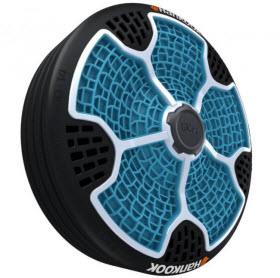
As car technology ranging from stop-start engines to active safety systems continue to evolve at a breakneck pace, the lowly tire hasn’t changed much in the past century.
While new compounds make tires stickier, last longer and even let you keep driving with a "flat," the tire is still a rubber doughnut filled with air and clinging to a metal wheel.
But thanks to recent advances in the development of "smart" materials, tire technology could be ready to make a leap into the 21st Century.
Swapping out tires between summer and winter for those who live in cold climates, using separate tires for track and highway driving and even getting flats could be things of the past. In addition, "airless" tires that incorporate a car's wheel as a seamless unit could make for smoother, quieter and more fuel-efficient driving.
Like most materials-based technology, automobile tires represent a compromise. No single type of tire is ideal for every driving situation, road surface or type of weather. Tires that provide good adhesion in the summer during warm conditions won’t give a car the best grip in the snow and slush of winter. And although “all-season” radial tires do a reasonable job of balancing handling and ride quality across a wide variety of road surfaces and environments, they're also a compromise.
There's no such thing as a perfect tire – yet. A team of researchers at the University of Applied Sciences in Leipzig, Germany is working on a tire that can automatically adjust to perform optimally in any condition. Lead researcher Detlef Riemer and his team are developing an "adaptive tire" that can change with various road and weather conditions to provide both the best possible grip and ideal fuel efficiency.
The tire would recognize changes in road surfaces and environmental conditions thanks to sensors embedded in the rubber, while actuators would realign the tread geometry for optimal grip for the given conditions. To make this research a reality, Riemer and his team are experimenting with cutting-edge materials such as piezo-ceramic actuators and shape-memory alloys that work in harmony to keep a tire's rubber stuck to the road.
The Korean tire manufacturer Hankook is working on another concept called the i-Flex that literally takes the air out of a car’s tires. Originally developed by Bridgestone and other tire companies, the I-Flex merges the wheel and tire into a one-piece unit. Hankook said the design not only does away with flats, but also absorbs bumps better than regular rubber tires do.
Using an elaborate arrangement of geometric cells bordering the inside of the "wheel," the whole i-Flex functions as a unified suspension component. This means that energy from bumps that typically jar a car is equally dispersed and dissipated across the entire structure. This offers a constant rigidity that has never been possible with a traditional tire-and-wheel combo.
Since overall weight is reduced with the i-Flex, it also has the potential to increase fuel economy, and handling would be improved, because unsprung weight (the weight of the brakes, wheels and tires) is lessened at each corner of a car. The i-Flex is also 95 percent recyclable, making it much greener than traditional tires.
To boot, Hankook promises that the i-Flex will run quieter than rubber tires. This could prove to be a big advantage for electric vehicles since, in the absence of engine noise, the sound of tires on pavement is amplified.
Don’t expect to see the i-Flex or adaptive tires at the auto parts store down the street any time soon, though. Hankook isn’t giving a specific time for when the i-Flex will be on the market, and the German research team noted that adaptive tires, still just a concept, won't be commercially viable for years. And both types of futuristic tires will need to go through a barrage of safety and durability tests to meet federal standards before they're ready to roll on public roads.
Until then, we're stuck with the century-old technology of an air-filled rubber doughnut stuck to a metal wheel – and flats.
Doug Newcomb has been covering car technology for more than 20 years for outlets ranging from Rolling Stone to Edmunds.com. In 2008, he published his first book, "Car Audio for Dummies" (Wiley). He lives and drives in Hood River, Ore., with his wife and two kids, who share his passion for cars and car technology, especially driving and listening to music.
http://editorial.autos.msn.com/blogs/po ... autos_4764no crims



